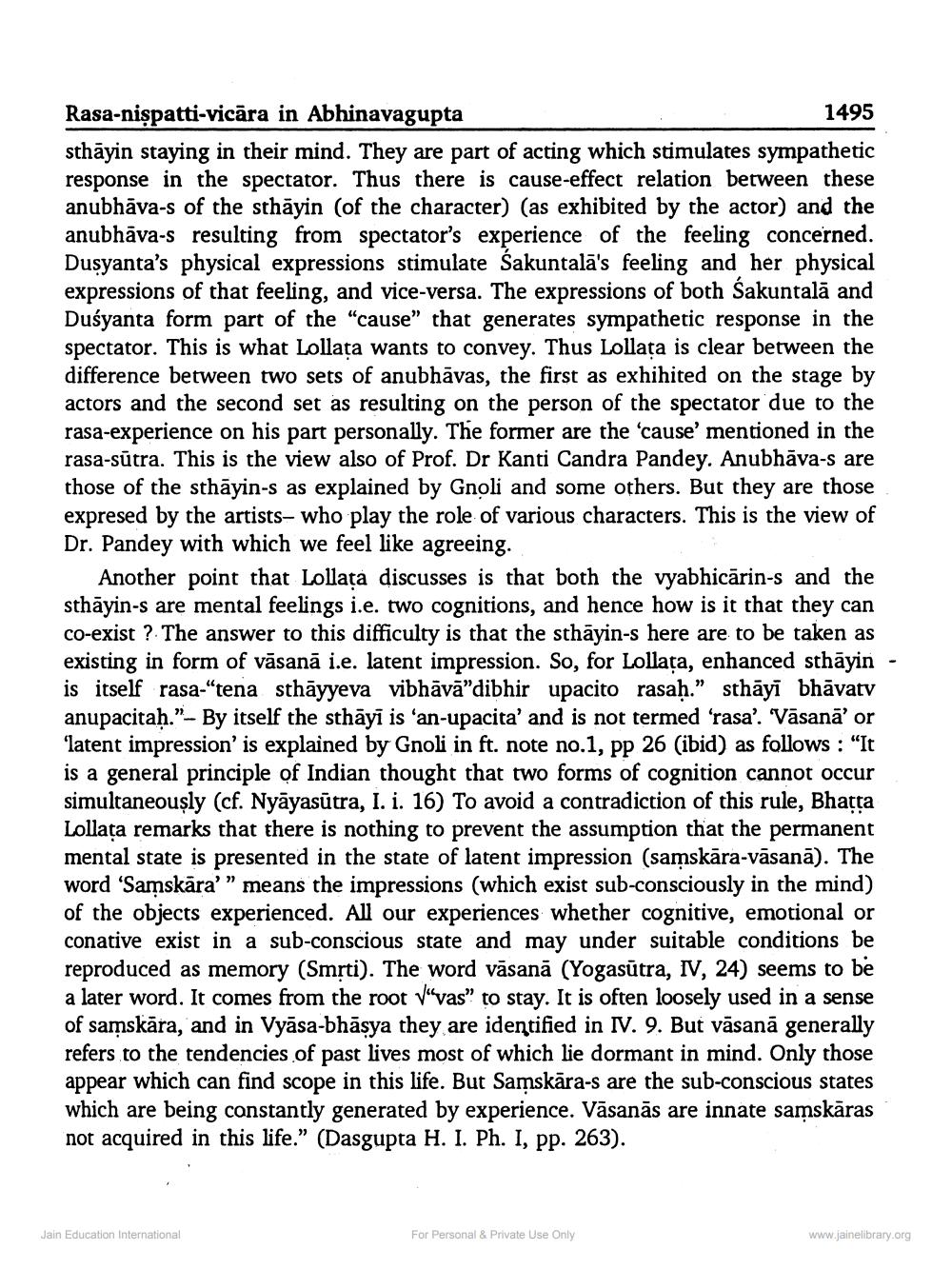________________
Rasa-nişpatti-vicāra in Abhinavagupta
1495 sthāyin staying in their mind. They are part of acting which stimulates sympathetic response in the spectator. Thus there is cause-effect relation between these anubhāva-s of the sthāyin (of the character) (as exhibited by the actor) and the anubhāva-s resulting from spectator's experience of the feeling concerned Dusyanta's physical expressions stimulate Sakuntalā's feeling and her physical expressions of that feeling, and vice-versa. The expressions of both Sakuntalā and Duśyanta form part of the “cause” that generates sympathetic response in the spectator. This is what Lollata wants to convey. Thus Lollata is clear between the difference between two sets of anubhāvas, the first as exhihited on the stage by actors and the second set as resulting on the person of the spectator due to the rasa-experience on his part personally. The former are the 'cause' mentioned in the rasa-sūtra. This is the view also of Prof. Dr Kanti Candra Pandey. Anubhāva-s are those of the sthāyin-s as explained by Gnoli and some others. But they are those expresed by the artists, who play the role of various characters. This is the view of Dr. Pandey with which we feel like agreeing.
Another point that Lollaţă discusses is that both the vyabhicārin-s and the sthāyin-s are mental feelings i.e. two cognitions, and hence how is it that they can co-exist ? The answer to this difficulty is that the sthāyin-s here are to be taken as existing in form of vāsanā i.e. latent impression. So, for Lollata, enhanced sthāyin - is itself rasa-tena sthāyyeva vibhāvā"dibhir upacito rasah." sthāyī bhāvatv anupacitaḥ."- By itself the sthāyī is 'an-upacita' and is not termed 'rasa'. 'Vāsanā' or latent impression' is explained by Gnoli in ft. note no.1, pp 26 (ibid) as follows : "It is a general principle of Indian thought that two forms of cognition cannot occur simultaneously (cf. Nyāyasūtra, I. i. 16) To avoid a contradiction of this rule, Bhatta Lollata remarks that there is nothing to prevent the assumption that the permanent mental state is presented in the state of latent impression (samskāra-vāsanā). The word 'Samskara'” means the impressions (which exist sub-consciously in the mind) of the objects experienced. All our experiences whether cognitive, emotional or conative exist in a sub-conscious state and may under suitable conditions be reproduced as memory (Smrti). The word vāsanā (Yogasūtra, IV, 24) seems to be a later word. It comes from the root Vvas" to stay. It is often loosely used in a sense of samskāra, and in Vyāsa-bhāsya they are identified in IV. 9. But vāsanā generally refers to the tendencies of past lives most of which lie dormant in mind. Only those appear which can find scope in this life. But Samskāra-s are the sub-conscious states which are being constantly generated by experience. Vāsanās are innate samskaras not acquired in this life.” (Dasgupta H. I. Ph. I, pp. 263).
Jain Education International
For Personal & Private Use Only
www.jainelibrary.org




